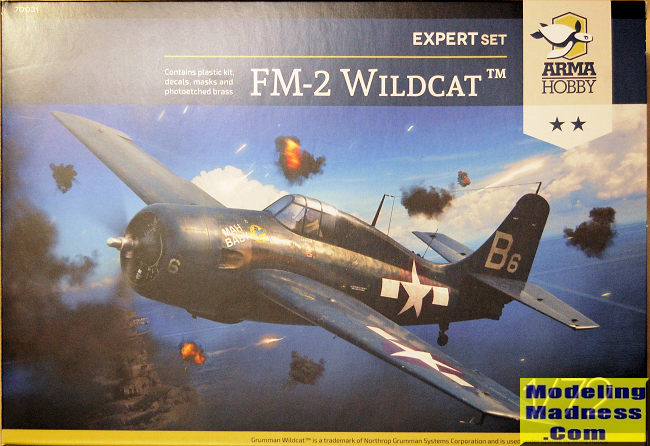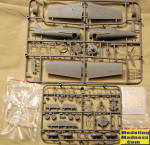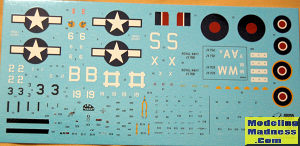
Arma Hobby FM-2 Wildcat
| KIT #: | 70031 |
| PRICE: | 20.50 Euros |
| DECALS: | Six options |
| REVIEWER: | Steve Alvin |
| NOTES: | New Tool |

| HISTORY |
With the success of the Escort Carrier, in 1942 the Navy put out a request for a new lightweight fighter. While the F4F-4 could and did operate successfully from these carriers, the Navy wanted a fighter with lighter weight and more power that could operate from a short flight deck. Grumman responded with the XF4F-8, a new, lightweight, version of the venerable Wildcat. This “Wilder Wildcat” replaced the F4F-4’s Pratt & Whitney 1200 hp R-1830 with a lighter, nine cylinder, 1350 hp Wright R-1820 with a single stage supercharger. The Wright engine produced additional torque and the second XF4F-8 was built with a taller tail. The aircraft’s weight was further reduced by eliminating the internal reserve fuel tank and reducing the armament from six to four .50 caliber machine guns. The results impressed the Navy as the new fighter operated easily from Escort Carriers, had a greater rate of climb, and was marginally faster than the F4F-4. As Grumman was committed to building the F6F, production of the Wildcat as transferred to the Eastern Aircraft Division of General Motors. Renumbered FM-2, over 4,400 “Wilder Wildcats” were delivered, including 340 to the British, before production ended in 1945. This was over half of all Wildcats produced.
The FM-2’s operational career was not particularly glamorous, but it was essential. In the Atlantic they flew from escort carriers in composite squadrons with TBM Avengers to protect convoys and to hunt U-Boats. Combined with improved cooperation with escort destroyers, they helped to all but eliminate the U-Boat threat.
In the Pacific they supported amphibious invasions by providing close air support to the Marines and Army troops. Later versions of the FM-2 were equipped to carry three rockets under each wing. They also hunted Japanese submarines. The single stage supercharger limited the plane’s effectiveness to low and medium altitude. But on the rare occasion they did meet Japanese aircraft, they gave good accounts of themselves. Four FM-2 pilots became Aces. In fact, the leading Navy Wildcat Ace, Lt. Ralph Elliot, achieved all of his nine victories flying the FM-2 with VC-27. Probably the greatest day for the FM-2 was October 25, 1944. In cooperation with F6F’s and TBM’s from “Taffy” 1, 2, and 3 they bombed, strafed, and rocketed the battleships and cruisers of Admiral Kurita’s Center Force during the Battle off Samar.
| THE KIT |
 Both
MPM and Sword have produced FM-2’s. As short run kits, they had lots of issues.
While technically a short run kit, Arma’s FM-2 is by far the best of the lot.
The Expert Series includes
masks for the canopy and the wheels. A small photo etch fret includes parts,
like the instrument panel for the interior, the engine, and, as a nice touch,
the chainlink that was part of the gear raising mechanism. Decals are provided
for the various panels in the cockpit.
Both
MPM and Sword have produced FM-2’s. As short run kits, they had lots of issues.
While technically a short run kit, Arma’s FM-2 is by far the best of the lot.
The Expert Series includes
masks for the canopy and the wheels. A small photo etch fret includes parts,
like the instrument panel for the interior, the engine, and, as a nice touch,
the chainlink that was part of the gear raising mechanism. Decals are provided
for the various panels in the cockpit.
The molding is excellent with finely recessed panel lines. There is no flash or noticeable sinkholes. It is comparable to mainline kits. Positive locator holes are on the main pieces. The elevators and rudder are molded separately. Two types of propeller hubs, main wheels, and tail wheels are provided. A pair of drop tanks and six HVAR rockets are also included. The fuselage and wings fit the 1/72nd scale drawings in Osprey’s Wildcat Aces book.
 The
instructions look straight forward. They include full color plans for the six
marking options. There are three Pacific schemes, two in overall gloss Sea Blue
and one in mid-War tri-color scheme. Two Atlantic schemes of Gull Grey and White
are included. The last option is for a Fleet Air Arm Wildcat VI. The painting
guide includes FS colors and for six different paint lines. The decals are by
Techmod and look very good.
The
instructions look straight forward. They include full color plans for the six
marking options. There are three Pacific schemes, two in overall gloss Sea Blue
and one in mid-War tri-color scheme. Two Atlantic schemes of Gull Grey and White
are included. The last option is for a Fleet Air Arm Wildcat VI. The painting
guide includes FS colors and for six different paint lines. The decals are by
Techmod and look very good.
The only downside I can see is that that the fairings on the underside of the wings look a little too large.
| CONCLUSIONS |
If it goes together as well as it looks, it will rival the Airfix F4F-4 as the best Wildcat in 1/72nd scale.
| REFERENCES |
Kinzey, Bert; F4F & FM Wildcat in Detail and Scale, 2018
Tillman, Barrett; Wildcat Aces of World War 2, Osprey Aircraft of the Aces #3, 1995.
June 2020
Copyright ModelingMadnesscom
If you would like your product reviewed fairly and fairly quickly, please contact the editor or see other details in the Note to Contributors.
Back to the Main Page Back to the Review Index Page Back to the Previews Index Page